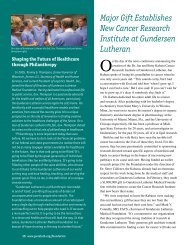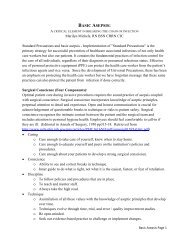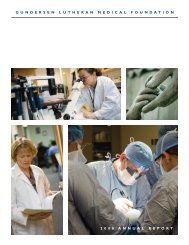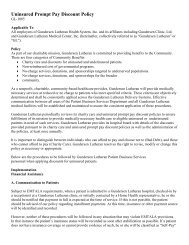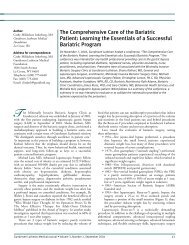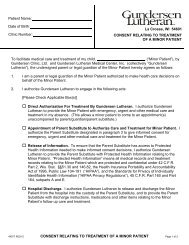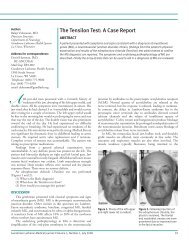Streptococcus bovis - Gundersen Lutheran Health System
Streptococcus bovis - Gundersen Lutheran Health System
Streptococcus bovis - Gundersen Lutheran Health System
You also want an ePaper? Increase the reach of your titles
YUMPU automatically turns print PDFs into web optimized ePapers that Google loves.
intrACrAniAL MyCotiC AneurySM due to StreptococcuS boviS endoCArditiS<br />
Large lobulated mycotic aneurysm arising from the internal carotid<br />
artery is indicated by the white arrow.<br />
new, right basal ganglia and right frontal lobe intraparenchymal<br />
hemorrhages consistent with rupture of the mycotic aneurysm.<br />
The patient’s family opted for comfort care measures, and the<br />
patient died shortly thereafter. An autopsy was not performed.<br />
diSCuSSion<br />
Mycotic aneurysms can be divided into 4 types: (1) embolic,<br />
secondary to bacterial endocarditis (embolomycotic aneurysms);<br />
(2) extravascular, secondary to extension of contiguous infection<br />
from a septic focus neighboring an artery; (3) cryptogenic or primary<br />
bacteremic; and (4) direct contamination following arterial wall<br />
trauma, which may be postprocedural. 6 Aneurysms can occur in<br />
the cerebral circulation, usually at points of vessel bifurcation, or<br />
in the systemic circulation. 7 In IE-associated mycotic aneurysms,<br />
septic emboli are released from infected cardiac vegetations. These<br />
tiny septic emboli occlude the vasa vasorum or entire arterial lumen,<br />
which leads to damage to the muscular layer of the vessel. ICMA<br />
tend to occur in the more distal portions of the middle cerebral<br />
artery, near the surface of the brain, involving the secondary and<br />
tertiary branches. In contrast, berry aneurysms occur at proximal<br />
branch points in or near the circle of Willis. 4 The outcome depends<br />
upon the anatomical location of the embolus, the causative<br />
bacteria and associated virulence of the organism, underlying host<br />
defenses, and appropriate antibiotic therapy. Mycotic aneurysms<br />
can decrease, increase, remain the same in size, or even disappear<br />
during treatment for endocarditis. 8<br />
Patients with bacterial intracranial aneurysms have<br />
variable neurological symptoms, and early symptoms of<br />
infection may be subtle. In ICMA, patients may have<br />
symptoms ranging from nonspecific, general complaints,<br />
including fever or headache, to neurological deficits or<br />
catastrophic intracranial hemorrhage. Laboratory results are<br />
typically suggestive of an underlying inflammatory process and<br />
may include leukocytosis, elevated erythrocyte sedimentation<br />
rate and/or C-reactive protein concentration, and anemia. Blood<br />
cultures are almost universally positive for microbial growth.<br />
Computed tomographic angiography, magnetic resonance<br />
angiography (MRA), and catheter angiography are used to study<br />
the size, location, and morphology of intracranial aneurysms.<br />
Aneurysms 5 mm in diameter or larger can be detected by CTA and<br />
MRA. Smaller aneurysms are detected less reliably or detected in<br />
retrospect after comparison with cerebral angiography. 9-11 Cerebral<br />
angiography is the gold standard and is often used in preoperative<br />
assessment and in determining prognosis 12 ; however, it is not<br />
routinely recommended due to risk of complications associated<br />
with it. The size of the aneurysm during therapy can be safely and<br />
accurately monitored using CTA and MRA. In our patient, CTA<br />
was selected as the diagnostic tool.<br />
Treatment of ICMA is controversial, in that the appropriate<br />
patients for surgical intervention, need for follow-up imaging,<br />
and most efficacious treatment are not well delineated in the<br />
medical literature. The appropriate treatment always involves<br />
medical and sometimes surgical therapies. 13 Moreover, there is no<br />
single uniformly accepted approach to the treatment of ICMA<br />
in IE. The aim of therapy is to cure the underlying infection<br />
and avoid complications from the aneurysm. Some lesions will<br />
resolve with antibiotic therapy alone. The decision to pursue<br />
surgical management is complex and involves a number of factors,<br />
including the number, site, and anatomy of the aneurysm(s) and<br />
the comorbidities of the patient. Treatment options for unruptured<br />
aneurysms include observation or surgical approaches, such as<br />
craniotomy and clipping or endovascular coiling. 14,15 The surgical<br />
choice of treatment for ICMA is controversial, patient-specific, and<br />
is generally beyond the scope of this article. Four- to 6-week courses<br />
of pathogen-specific intravenous antibiotic are recommended.<br />
In addition, medical therapy should include control of<br />
hypertension and seizures. Therapy should be monitored with<br />
serial CTA or MRA, and surgical intervention is generally<br />
recommended for enlarging aneurysms in accessible locations.<br />
Ruptured aneurysms are treated emergently with surgery to<br />
prevent rebleeding if possible.<br />
Staphylococcus aureus (~30%), Salmonella species (~15%),<br />
and less commonly viridans group streptococci are some of<br />
the causitive organisms of mycotic aneurysms in the<br />
postantibiotic era. 16 Recent reports suggest <strong>Streptococcus</strong><br />
pneumoniae, including penicillin-resistant strains, are re-emerging<br />
as a cause of mycotic aneurysms. 17 Our patient was infected<br />
with <strong>Streptococcus</strong> <strong>bovis</strong>, a gram-positive cocci classified as group<br />
D streptococci. Endocarditis is the most significant clinical<br />
infection associated with S <strong>bovis</strong>, but bacteremia from enteric<br />
origins also occurs. S <strong>bovis</strong> accounts for 2% to 6% of streptococcal<br />
bloodstream isolates from hospitalized patients and for 2.4% to<br />
25% of organisms associated with IE. 18-22 S <strong>bovis</strong> is a rare cause of<br />
ICMA, however. Interestingly, S <strong>bovis</strong> endocarditis or bacteremia<br />
is associated with concomitant undiagnosed gastrointestinal (GI)<br />
tumors in up to 56 % of patients. 23 GI diseases associated with S<br />
<strong>bovis</strong> endocarditis include colonic cancers, gastric ulcers, gastric<br />
<strong>Gundersen</strong> <strong>Lutheran</strong> Medical Journal • Volume 6, Number 1, June 2009 19








